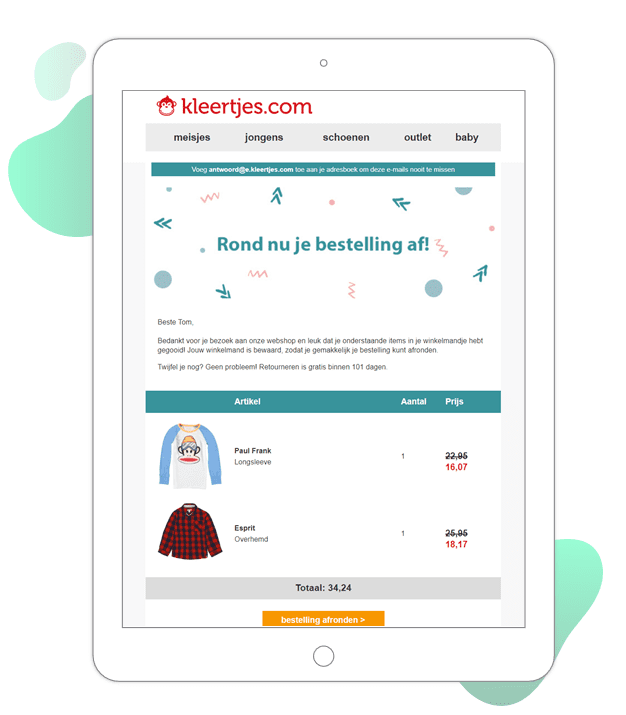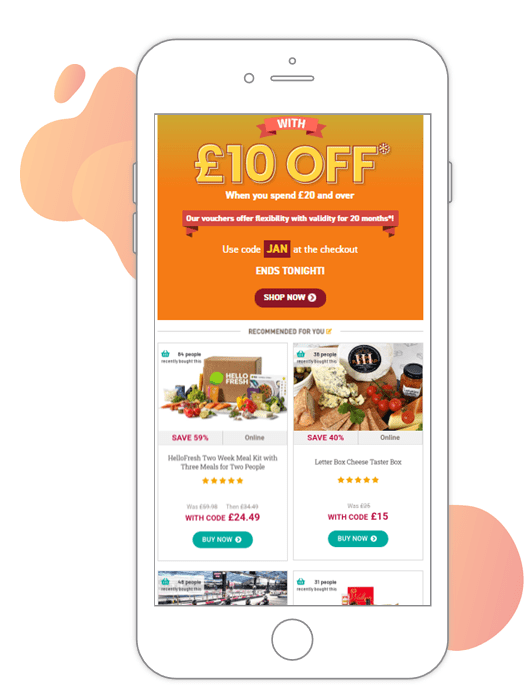Email marketers are busy people. The need to send customers relevant and timely content, coupled with limited resources and the pressure to create more and more campaigns means time that should be spent strategizing is often eaten up designing emails and curating content.
If you want to win back time and up your strategy, you’ll need to equip yourself with the right functionality and tools to help you deliver emails that make your customers (and your boss) happy.
Read on to find out which email functionality you should be utilizing in your business to save time, generate results and create exceptional customer experiences.
1) Triggered emails
It’s nice to have your needs anticipated, whether that’s a cup of coffee brought to your desk just as you need a caffeine boost, or an email from the brand you love telling you those jeans you looked at last week have dropped in price.
By responding to customers’ individual needs in real time, email marketers can improve the customer experience, bring shoppers back to the website, and generate significant incremental revenue.
To achieve this, you’ll need triggered email functionality.
With triggered emails, marketers are empowered to treat customers as individuals by sending a message directly linked to their shopping behavior.
Customers who take a predefined action (such as abandoning their cart) are automatically sent an email that nudges them towards the next action (like completing their purchase).
Shoppers see the most relevant content at the moment they’re most engaged with your brand, which means they’re more likely to open, click through to your website, and convert. Plus, having triggered email programs in place takes the pressure off busy email marketers, as having a better split between time-consuming BAU newsletters and automated triggered emails frees up time to focus on other projects.
Cart abandonment emails are probably the most well known type of triggered email and are proven to generate results. In fact, Fresh Relevance client Kleertjes.com has seen a 347% YOY increase for cart abandonment revenue with their multi-step abandonment emails.

Using a general-purpose tool like an ESP can work well if you’re only going to be sending basic triggered messages such as purchase complete emails. Cart abandonment can also work, but your send rates and conversions will be lower if you can’t identify customers who weren’t logged in when they browsed or carted.
If your ESP is lacking browse and form abandonment, or any type of sophisticated personalization, you’re likely better off considering a purpose-built solution like Fresh Relevance.
2) Behavioral targeting
Savvy marketers know the best performing emails are the ones that are tailored to each recipient with smart segmentation.
For a complete picture of shoppers’ needs, you’ll need to collect transactional and behavioral data from every channel where customers interact with your brand. You can then use this data to segment customers into lists and target them based on their interests, customer lifecycle stage, and position in the buying cycle.
Once your segments are up and running, you can use them to boost conversions from bulk and triggered emails whilst delivering content your shoppers actually want to receive. Win win.
Learn more: 9 types of segmentation you should be using to drive conversions
However, segmentation isn’t always simple and it can be difficult to get your hands on the right tools and data to segment customers effectively. Often, behavioral and transactional customer data sit in inaccessible silos, in an unhelpful format. Accessing this data for marketing campaigns can be slow if your technical team has to pull back-end data from your eCommerce platform. And creating email marketing segments can mean manually moving around large quantities of personal data which poses challenges under GDPR.
To make segmentation easier, you can adopt a real-time personalization platform like Fresh Relevance. Our platform integrates customer data across systems in real time, including your ESP, eCommerce platform, and customer database. You can also start capturing activity before a customer signs up, and tie their identity back to their behavior once they’re identified.
Our segment builder allows marketers to quickly access and implement real-time customer data without relying on other teams. You can also combine segments with marketing rules to engage customers with specific content based on your business objectives.
3) Product recommendations
On-site product recommendations have come a long way. But when it comes to email, marketers often have to settle for manually curated product suggestions. These are a good start, but don’t guarantee a relevant experience for customers and are often time consuming to set up.
But with the right technology, you can leverage website data to build email recommendations that are both targeted and compelling, whilst cutting down the process of creating your marketing emails.
Product recommendations based on a combination of wisdom of the crowd and customer data – such as their location, browsing and buying behavior – can offer a more curated experience. This in turn increases relevancy, streamlines the purchase journey and aids discovery.
There are plenty of types of product recommendations to choose from, so it’s important to test what works best for your shoppers, as well aligning recommendations to each stage of the customer journey.
Learn more: 8 product recommendation examples for every stage of the customer journey
Buyagift were able to improve the relevancy of their product recommendations and automate the selection process by using Fresh Relevance’s product recommendation functionality in their emails. This has helped them achieve a 24% sales uplift and save time on email setup.

4) Dynamic content
When done manually, it’s a challenge to create engaging content at scale that’s relevant to each recipient. But email marketers who have dynamic content functionality at their disposal can automatically generate engaging creative that’s unique, relevant, and up-to-date at the instant a customer opens an email.
Many types of dynamic content pull in information from your website, so there’s limited creation required – always a bonus for busy marketers.
There are many ways to include dynamic content in your email marketing, but one of the most effective ways to make a good impression on your customers the second they open your email is with a dynamic hero banner. Transforming your banner into a piece of dynamic content allows you to show each customer the image that’s most likely to spark their interest and encourages them to click through to your website. Try including imagery of the carted brand or product in cart abandonment emails, or beef up your bulk emails by pulling customer details into your banner.
Animed Direct gave their BAU newsletters a boost with Fresh Relevance’s dynamic content SmartBlocks, pulling in the name of the customer’s pet for their Christmas launch email.

With the right technology in place, it’s never been easier to delight customers and drive revenue through marketing emails. Automate better-converting lifecycle campaigns, coordinate customer data and convert more shoppers into customers with Fresh Relevance.







